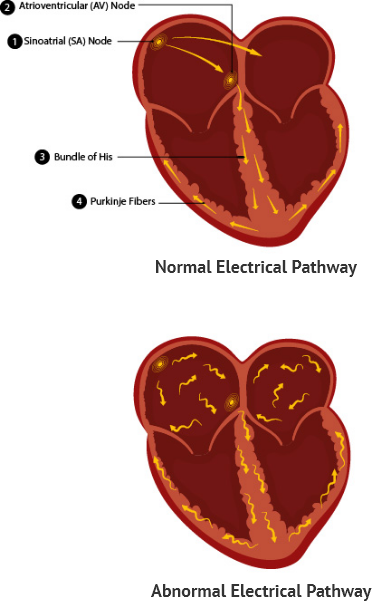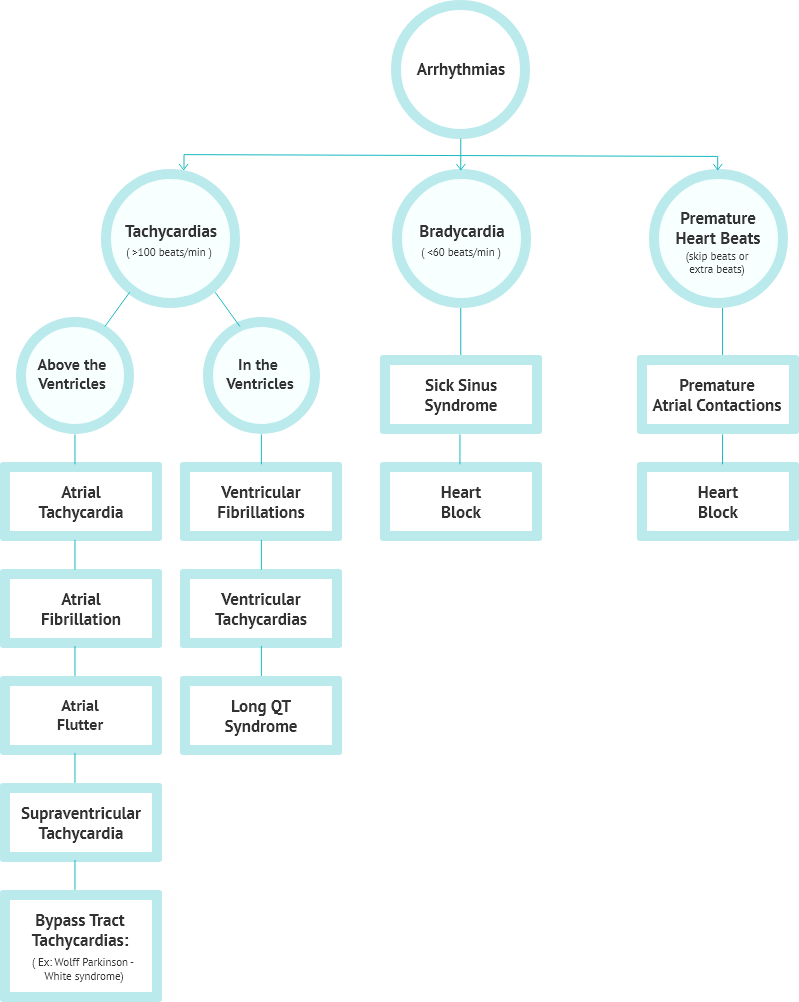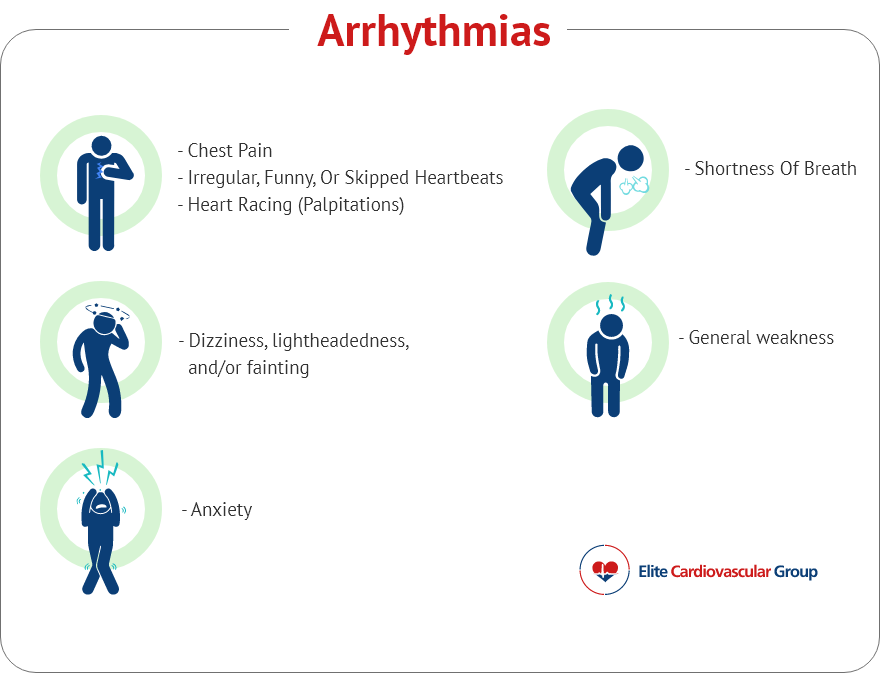Arrhythmias

Also known as: Abnormal/irregular heartbeat
The normal electrical pathway: 1) SA Node → 2) AV Node → 3) Bundle of His → 4) Purkinje Fibers
An arrhythmia can be simply defined as an abnormal heartbeat. The heart has a specialized group of cells called the pacemaker/SA Node that sets the rhythm by sending electric signals to the whole heart.
The normal heart rate is about 60 to 80 beats per minute. When the rhythm becomes too fast (tachycardia), too slow (bradycardia), or unpredictable, the heart can’t squeeze blood out efficiently. And if the blood is not squeezed out, it cannot supply the necessary oxygen and other essential nutrients to the different organs in the body.
Based on how and where the rhythm is interrupted in the heart, arrhythmias can be divided accordingly (see below).

Also known as: A Fib, quivering heart
Atrial Fibrillation is the most common type of arrhythmia. The heartbeat is irregular, meaning that sometimes it can cause symptoms while at other times it may not. People often feel the symptoms when their heart rate is more than 100 beats per minute. The electric impulse going from the Sinoatrial Node (SA Node) to the Atrioventricular Node (AV Node) is disturbed as seen in the diagram below.
Instead of the SA Node being the starting point of the electric pathway, multiple starting points crop up throughout the atria and send electrical impulses in different directions. Therefore, the top two chambers (right and left atria) of the heartbeat in an unpredictable manner (“quivering”) without coordinating with the bottom two chambers (right and left ventricles). This lack of synchronization causes a weak squeezing action of the heart and therefore slow blood flow in the ventricles. This causes low blood flow to the rest of the body.
A common complication of the slow blood flow is clot formation, which can increase your risk of a stroke. This is why doctors often recommend blood thinners if you are not at high risk of bleeding.
Types of A-Fib:
- Occasional (Paroxysmal) – no specific pattern, irregular heartbeats come and go on their own with the regular rhythm in between
- Persistent – irregular beats last more than a week but less than 12 months
- Long-Standing Persistent – irregular beats last more than 12 months
- Permanent – irregular beats cannot be normalized again despite treatment

Note: Not everyone may experience all symptoms
- High blood pressure
- Heart attack
- Coronary artery disease
- Thyroid imbalances
- Abnormal heart valves
- Exposure to stimulants, such as medications, illicit drugs such as cocaine, too much caffeine, tobacco or alcohol
- Long standing lung disease
- Previous heart surgery
- Viral infections
- Sleep apnea
- Stress/anxiety
Show references
Tse G. Mechanisms of cardiac arrhythmias. J Arrhythm. 2016;32(2):75-81. doi:10.1016/j.joa.2015.11.003
Panchal AR, et al. 2018 American Heart Association focused update on advanced cardiovascular life support use of antiarrhythmic drugs during and immediately after cardiac arrest. Circulation. 2018;138:e740.
Desai DS, Hajouli S. Arrhythmias. [Updated 2020 Jun 25]. In: StatPearls [Internet]. Treasure Island (FL): StatPearls Publishing; 2020 Jan-. Available from: https://www.ncbi.nlm.nih.gov/books/NBK558923
Glinge C, Sattler S, Jabbari R, Tfelt-Hansen J. Epidemiology and genetics of ventricular fibrillation during acute myocardial infarction. J Geriatr Cardiol. 2016;13(9):789-797. doi:10.11909/j.issn.1671-5411.2016.09.006
Staerk L, Sherer JA, Ko D, Benjamin EJ, Helm RH. Atrial Fibrillation: Epidemiology, Pathophysiology, and Clinical Outcomes. Circ Res. 2017;120(9):1501-1517. doi:10.1161/CIRCRESAHA.117.309732
Cosío FG. Atrial Flutter, Typical and Atypical: A Review. Arrhythm Electrophysiol Rev. 2017;6(2):55-62. doi:10.15420/aer.2017.5.2
Spartalis M, Spartalis E, Tzatzaki E, et al. Novel approaches for the treatment of ventricular tachycardia. World J Cardiol. 2018;10(7):52-59. doi:10.4330/wjc.v10.i7.52
European Heart Rhythm Association; Heart Rhythm Society, Zipes DP, et al. ACC/AHA/ESC 2006 guidelines for management of patients with ventricular arrhythmias and the prevention of sudden cardiac death: a report of the American College of Cardiology/American Heart Association Task Force and the European Society of Cardiology Committee for Practice Guidelines (Writing Committee to Develop Guidelines for Management of Patients With Ventricular Arrhythmias and the Prevention of Sudden Cardiac Death). J Am Coll Cardiol. 2006;48(5):e247-e346. doi:10.1016/j.jacc.2006.07.010
https://www.cardiosmart.org/topics/atrial-fibrillation
